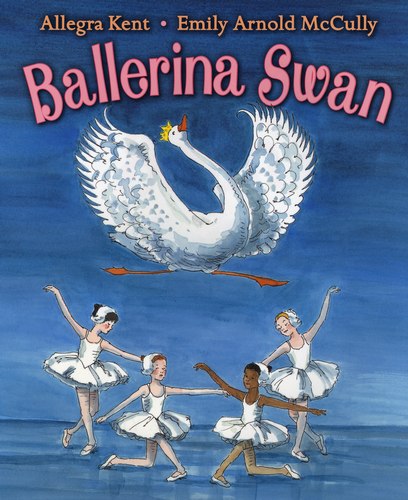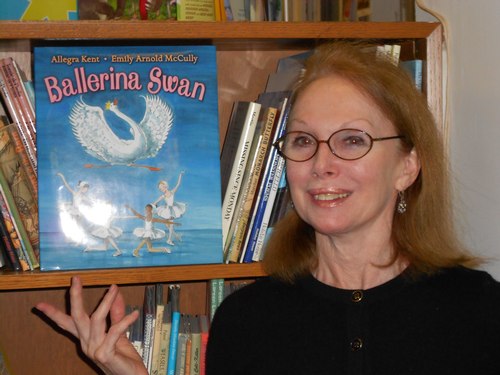|
 |
|
|
 |
 |
If you are a serious birder or a serious dancer, you should add Allegra Kent and Emily Arnold McCully's Ballerina Swan to your life list. There is a long tradition of dancers trying to become swans, extending back to the premiere of The Lake of the Swans by the Bolshoi Ballet in 1877, now called Swan Lake. Fokine premiered The Dying Swan in 1905. These two ballets may be the only prominent swan dances, but they have been danced repeatedly in many variations, such as a silent film with the Bolshoi ballerina Vera Karalli in 1916, another with Pavlova in about 1925, Balanchine's Swan Lake in which Ms. Kent danced, and the Royal Ballet's version with Fonteyn, among many other productions by other dance companies. (Thanks to Mindy Aloff for the dance history highlights.) These avian dance productions have been beloved of many audiences. ExploreDance.com is no exception: we love dancers as swans too. One of our fashion shoots produced a classic dancer as swan image. Ballerina Swan puts a new twist on this dancer to swan tradition. In this charming new children's book written by former New York City Ballet principal dancer and George Ballanchine protégée Allegra Kent, Sophie, a real swan who lives in a pond in a city park, sees children dancing in a ballet class. Sophie decides she, a swan, wants to become a dancer just like the children. Obstacles are thrown in her way. Sophie perseveres, practices and performs, including a triumphant grand jeté with perfectly straight legs. While Ballerina Swan did please me, my opinion is secondary. What really matters when judging a children's book is how the intended audience reacts. When the intended audience is as young as three years old, this isn't an easy measure to take. As verbal as our kids may be, they have limited tools with which to express their likes and desires. Fortunately, Ballerina Swan is a book about dance, so there is a way to accurately measure children's response to the book: does it inspire them to dance? I have strong evidence that Ballerina Swan inspires kids to dance. I read Ballerina Swan to my three and a half year old daughter. The story held her attention even though she was also watching The Backyardigans at the same time (a fierce dance competitor if there ever was one, and while I prefer reading books to my daughter without distractions, sometimes when you are trying to get something done you have to take the child's schedule on her own terms). When we were done reading the book, my daughter found the promotional sheet that was sent with the press packet. This is a one-pager that has eight small illustrations drawn from the book illustrating various ballet positions and moves. My daughter asked me how to do some of these dance moves, such as tendue and plié. I did my best to show her (I am a West Coast Swing dancer and ex-competitive ballroom dancer, not a ballet dancer). She then put the sheet on the floor and started imitating the illustrations. She pulled out the promotional sheet a couple more times that day and kept practicing. She did so again the next day. The day after that I took her to see a matinee of Rioult, and after the show she practiced the ballet moves on the sidewalk. She insisted on practicing again with the sheet a few days later. This is as clear as the evidence from a small child is ever going to get that Ballerina Swan has a positive impact on kids. And while for the first week or so it was the sheet of ballet positions that held her attention, and not the book itself, more recently I asked her if she wanted me to read her the book and she said Yes. She listened attentively to the book from start to finish, and asked questions about what was shown in the illustrations. I have also heard reports from her school that she has been teaching her classmates the ballet moves she saw in Ballerina Swan. Next, I asked a friend who is a former dancer with the New York Theatre Ballet and an educator who has a five year old daughter to read Ballerina Swan. She thought the illustrations were good, and also were accurate representations of the dance positions. The vocabulary in the book was good too, both general words like "quell" and ballet terms, some of which, like épaulement, are less common in dance books for kids. She loved the glossary at the front of the book. A five year old can give more detailed feedback than a three year old. Her daughter noticed several important details in the book. When Sophie looks for her name on the cast list for the upcoming show, that felt like a real experience to my friend's daughter. She picked up on the fact that in the book there is a boy in the ballet class: to her this felt good and diverse because she doesn't have a boy in her own ballet class. She was very impressed with Sophie's straight legs in the grand jeté: she has been working on straight legs in her own grand jetés recently (with success). This feedback strongly suggests that if you have an older child who is a dancer, Ballerina Swan offers multiple points of entry from which the child can find a connection to the story. And after reading the book, she danced her pas de chats, which she accurately identified in one of the book's illustrations, as well as other steps - for 40 minutes. Another colleague who is an educator thought Sophie was expressive with good humor, such as where Sophie is depicted listening to the ballet's score with an iPod and headphones. My own analysis of Ballerina Swan suggests that there are small areas where the book could be improved, but given the field test evidence, these issues do not affect the impact of the book. And if Ms. Kent chooses to "correct" these issues, they can easily be addressed by writing a sequel, which will hopefully lead to a regular TV show on Nick Jr (in our house, we really like most of what is shown on Nick Jr). Why are all of the girls in the dance class wearing pink? I realize it is traditional, but it also stereotypes girls as delicate. Why not a "strong" color like red? Or everyone could wear the same outfit, but in a rainbow of colors. Or everyone could wear black and white to match the one boy in class. The pink outfits do create consistency, which emphasizes Sophie's position as outsider. A children's book is not a novel, so focusing on one challenge to the status quo - the swan as dancer - is appropriate. But one could envision a sequel in which a new child shows up in a green leotard, leading to mayhem and lessons learned. And, I am just dreaming here, a Mallard duck dancing a waltz. Would a flamingo have an easier time fitting into a ballet class because she is pink like the other girls? A swan may be a transgressive addition to a dance class, but swans are generally considered beautiful animals. What might happen if an animal generally considered ugly, like a pigeon, wanted to dance? I can't take credit for this suggestion for a sequel: a pigeon is shown looking into the dance studio's window with Sophie on page 8. The biggest literary flaw is in the development of Madam Myrtle, the scary older dance teacher. In the beginning, Madam Myrtle shoos Sophie away from dance class. Later, when Sophie gets a part in the school recital, Madam Myrtle is supportive. Did Sophie's dancing convince Madam Myrtle that she was wrong to bar Sophie from class? Did Miss Willow, the younger teacher who takes over the class halfway through the book, have a passionate argument with Madam Myrtle about how one should embrace the new, the different, the feathered? Ballerina Swan works without this transformation being shown explicitly, and the book shouldn't necessarily be made longer, but this transformation could make for an interesting, informative and compelling story. The ending of Ballerina Swan makes visual sense, with Sophie performing a grand jeté in the big show after all her practice, but I would love to see a depiction of the entire show. Some in the audience were swans. Maybe one of them was a dance critic for Ornithology Arts Today. What unique perspective would a swan bring to the job of dance critic? And finally, to return to the beginning of the book, Sophie is a flying bird, but she lives in a pond. People live in a medium, air, which is invisible as we move through it. When water is moved through, it makes visible patterns. Water also has a three dimensional aspect that is a mirror of the three dimensional air. And both air and water, from the perspective of a bird, have a fourth dimension of time: energy limits on staying aloft in air, and breathing limits on staying underwater. Air and water meet at a permeable boundary that swans can transcend in a way that people can not. How might the visibility and dimensionality of a bird's natural media affect choreography? Ms. McCully's watercolor illustrations give a soft, dreamy look to the story while retaining precision of line. My practical advice for improving Ballerina Swan should be simple to implement: turn the promotional sheet into a visual glossary that is either included with the book as a pullout card, sold separately as a companion book, or made available electronically either on the web and/or as an iPad/Nook/Kindle app. My dream advice is that Allegra Kent and Emily Arnold McCully continue to tell beautiful stories. In the meantime, buy Ballerina Swan. There is a good chance your child will be inspired to dance.
 Ballerina Swan's cover Photo © & courtesy of Emily Arnold McCully |
|
 Allegra Kent Photo © & courtesy of Holiday House |
|
 Emily Arnold McCully Photo © & courtesy of Holiday House |
|
|
|




